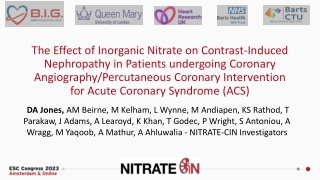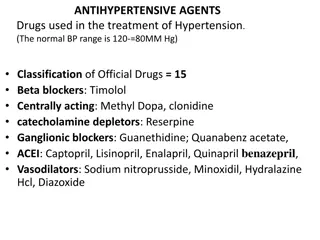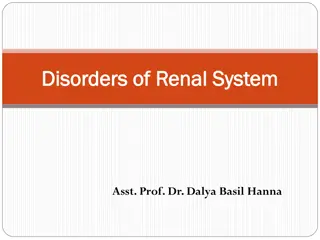The Role of Inorganic Nitrate in Preventing Contrast-Induced Nephropathy
Contrast-Induced Nephropathy (CIN) poses risks to patients undergoing angiography. This study evaluates the potential benefits of dietary inorganic nitrate in preventing CIN and its mechanisms. Results show promising renoprotective effects, highlighting a potential preventive approach for at-risk pa
1 views • 25 slides
Pathology of the urinary system
Focal segmental glomerulosclerosis (FSGS) is characterized by sclerosis of some glomeruli, while membranous nephropathy (MN) involves subepithelial immunoglobulin deposits. FSGS can lead to end-stage renal disease, with poor response to corticosteroid therapy. MN, on the other hand, shows diffuse ca
1 views • 20 slides
Overview of Antihypertensive Agents and their Mechanisms of Action
Explore the classification of antihypertensive agents used in treating hypertension, including beta blockers, centrally acting agents, ganglionic blockers, ACE inhibitors, vasodilators, and more. Learn about the Renin-Angiotensin System, ACE inhibitors, and specific drugs like Captopril and Benazepr
0 views • 9 slides
Key Issues and Uncertainties in Tert-Butanol (TBA) Induced Kidney Toxicity
This study discusses the key issues and uncertainties surrounding Tert-Butanol (TBA) induced kidney toxicity. It covers the role of alpha-2u globulin nephropathy, chronic progressive nephropathy (CPN), and the validity of concluding another unknown mode of action. Findings suggest TBA as a weak indu
0 views • 8 slides
Understanding Diabetic Glomerulosclerosis in Renal Disorders
Diabetic glomerulosclerosis is a condition characterized by thickening of the glomerular basement membrane, leading to increased permeability. It belongs to diabetic nephropathy and poses a risk for pyelonephritis. The progression of this disease involves the deposition of proteins in the mesangial
0 views • 19 slides




